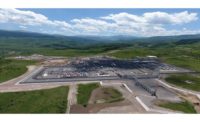Getting a new source of gas supply to Europe has been a topic of discussion within the European Union for the past two decades. It began long before the current crisis over Ukraine erupted between the U.S., Europe and Russia.
The collapse of the Soviet Union in 1991 gave rise to an acute and immediate interest among Western oil companies in the hydrocarbon resources that exist within the former Soviet republics, particularly those surrounding the Caspian Sea and especially Azerbaijan, which had been an oil-producing region for well over 150 years. (In fact, Azerbaijan’s hydrocarbon history goes back much further.)
In the 1990s, proposals began to appear regarding the construction of pipelines that would transport gas from the Caspian region to Europe. Many different routes were proposed, but, in 2002, serious talks began to take shape for what would be known as the Nabucco gas-pipeline project. The Nabucco consortium comprised energy companies from Austria, Hungary, Romania, Bulgaria and Turkey, and it was intended to transport the huge reserves of natural gas that exist in the Caspian region into central and Eastern Europe using Turkey as a transit state.
The entire concept of a route that would transport gas from the Caspian into Europe was being referred to as the "fourth corridor," or the "southern corridor"—Algeria, Norway and Russia being the first three corridors. Eventually, "southern corridor" became the preferred name.
The U.K.’s BP in the early 1990s secured the operatorship of several key production-sharing contracts in Azerbaijan’s offshore Caspian territory, one of which was for the Shah Deniz gas concession. Exploration work there led to the discovery, in 1999, of a gas field with reserves currently estimated at 1.2 trillion cu meters.
In late 2006, the Shah Deniz partners, headed by BP, began to produce gas at Shah Deniz and transport it from the Sangachal processing terminal, south of Baku, to Georgia through the newly built South Caucasus Pipeline (SCP); in July 2007, deliveries via the SCP arrived in Turkey, where the SCP hooked up with Turkey’s national gas grid at Erzurum.
The SCP was built in tandem with the 1-million-barrels-per-day-capacity Baku-Tbilisi-Ceyhan (BTC) crude-oil pipeline, which transports Azerbaijani oil from the offshore Azeri-Chirag-Guneshli (ACG) fields to Turkey’s Mediterreanean port of Ceyhan. It started operating in 2006, and, besides Azeri crude, it transports some other Caspian crudes, as well.
In December 2013, BP and its partners sanctioned the final investment decision for the Shah Deniz Stage 2 (SD2) development project, opening the way for the creation of the Southern Gas Corridor to Europe and the expansion of the SCP (SCPx).
Shah Deniz currently produces between 8 billion and 9 billion cu m per year of gas and around 50,500 barrels per day of condensate. According to BP Azerbaijan’s third-quarter business update, Shah Deniz produced some 7.25 billion cu m during the January-September period. Also, during this time, the SCP averaged a daily throughput of 17.412 million cu m, or a total of around 4.7 billion cu m (bcm) during the first three quarters of this year.
The SD2 project will boost the gas field’s output by another 16 bcm/year. Of that, 10 bcm/year will be transported to Europe through the southern gas corridor, which, at this time, comprises three components: the expanded SCP, the Trans-Anatolian Natural Gas Pipeline (TANAP) across Turkey, and the Trans-Adriatic Pipeline (TAP), which will carry SD2 gas from the Greek-Turkish border to Italy via a route through northern Greece, Albania and a subsea pipeline across the Adriatic Sea.




Post a comment to this article
Report Abusive Comment